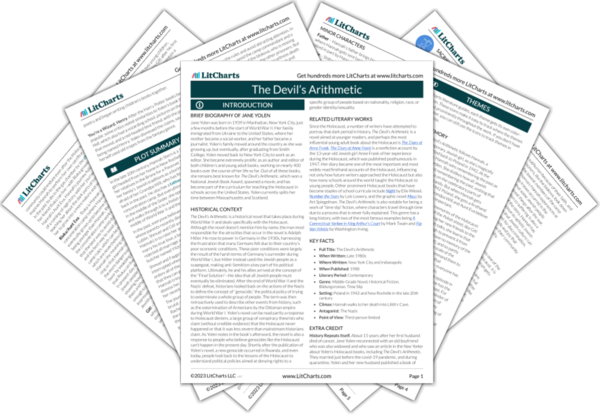Memory
The Devil’s Arithmetic follows Hannah, a contemporary Jewish girl, as she’s magically transported back to Poland in 1942. At the beginning of the story, Hannah sees remembering the past as nothing more than a burden. She dislikes how all Jewish holidays seem to be about remembering the past, wishing that instead she could just focus on the celebratory parts of holidays, like eating Easter candy. But when Hannah gets transported back in time to…
read analysis of MemorySacrifice
In Jane Yolen’s novel The Devil’s Arithmetic, the characters constantly make sacrifices big and small. The story begins with a Seder dinner, a Jewish tradition that has sacrificial elements built into it, such as a part where everyone at the table eats bitter herbs (to remind them of how their ancestors suffered) and a part near the end where everyone sacrifices some of their wine as an offering to the prophet Elijah. These small…
read analysis of SacrificeJewish Culture and Identity
The Devil’s Arithmetic begins with Hannah feeling reluctant about embracing her Jewish identity but ends with her understanding why this identity is so important to the adults in her family—and to her. While Hannah initially sees her Jewish heritage as a burden, she learns that it can also have a joyous side when she gets transported back in time to a Polish shtetl and witnesses Shmuel and Fayge’s wedding. Hannah experiences the kindness of…
read analysis of Jewish Culture and Identity
Hope
Although The Devil’s Arithmetic explores one of the darkest parts of human history, the Holocaust, it is nevertheless a hopeful novel. When Hannah gets transported back in time to the Holocaust, she is often surprised by how hopeful the Jewish people she meets are. Partly, this is because they don’t know the future and the full extent of the Nazi atrocities—as Hannah does—but even after experiencing the worst of the concentration camps, people like Gitl…
read analysis of Hope






